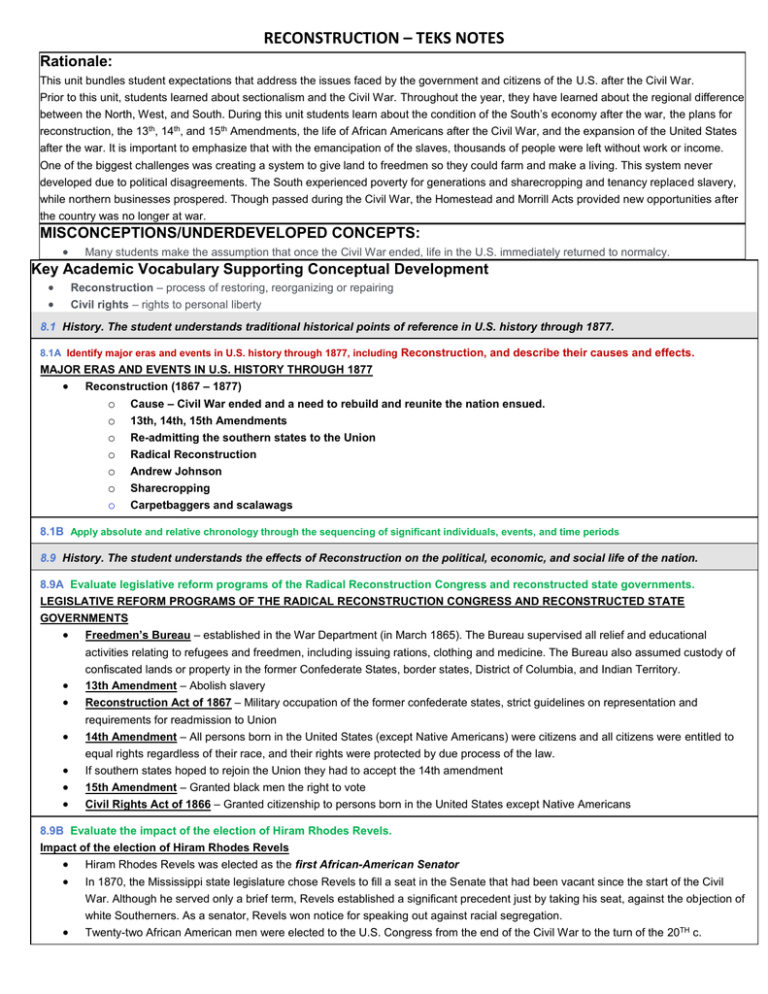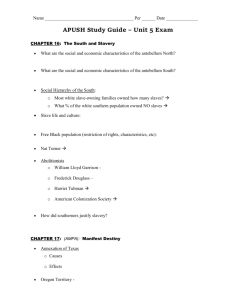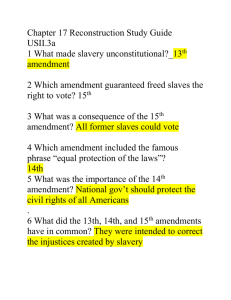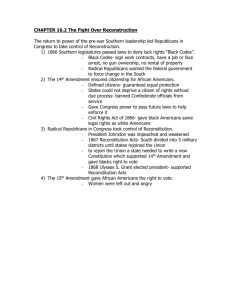reconstruction – teks notes
advertisement

RECONSTRUCTION – TEKS NOTES Rationale: This unit bundles student expectations that address the issues faced by the government and citizens of the U.S. after the Civil War. Prior to this unit, students learned about sectionalism and the Civil War. Throughout the year, they have learned about the regional difference between the North, West, and South. During this unit students learn about the condition of the South’s economy after the war, the plans for reconstruction, the 13th, 14th, and 15th Amendments, the life of African Americans after the Civil War, and the expansion of the United States after the war. It is important to emphasize that with the emancipation of the slaves, thousands of people were left without work or income. One of the biggest challenges was creating a system to give land to freedmen so they could farm and make a living. This system never developed due to political disagreements. The South experienced poverty for generations and sharecropping and tenancy replaced slavery, while northern businesses prospered. Though passed during the Civil War, the Homestead and Morrill Acts provided new opportunities after the country was no longer at war. MISCONCEPTIONS/UNDERDEVELOPED CONCEPTS: Many students make the assumption that once the Civil War ended, life in the U.S. immediately returned to normalcy. Key Academic Vocabulary Supporting Conceptual Development Reconstruction – process of restoring, reorganizing or repairing Civil rights – rights to personal liberty 8.1 History. The student understands traditional historical points of reference in U.S. history through 1877. 8.1A Identify major eras and events in U.S. history through 1877, including Reconstruction, and describe their causes and effects. MAJOR ERAS AND EVENTS IN U.S. HISTORY THROUGH 1877 Reconstruction (1867 – 1877) o o o o o o o Cause – Civil War ended and a need to rebuild and reunite the nation ensued. 13th, 14th, 15th Amendments Re-admitting the southern states to the Union Radical Reconstruction Andrew Johnson Sharecropping Carpetbaggers and scalawags 8.1B Apply absolute and relative chronology through the sequencing of significant individuals, events, and time periods 8.9 History. The student understands the effects of Reconstruction on the political, economic, and social life of the nation. 8.9A Evaluate legislative reform programs of the Radical Reconstruction Congress and reconstructed state governments. LEGISLATIVE REFORM PROGRAMS OF THE RADICAL RECONSTRUCTION CONGRESS AND RECONSTRUCTED STATE GOVERNMENTS Freedmen’s Bureau – established in the War Department (in March 1865). The Bureau supervised all relief and educational activities relating to refugees and freedmen, including issuing rations, clothing and medicine. The Bureau also assumed custody of confiscated lands or property in the former Confederate States, border states, District of Columbia, and Indian Territory. 13th Amendment – Abolish slavery Reconstruction Act of 1867 – Military occupation of the former confederate states, strict guidelines on representation and requirements for readmission to Union 14th Amendment – All persons born in the United States (except Native Americans) were citizens and all citizens were entitled to equal rights regardless of their race, and their rights were protected by due process of the law. If southern states hoped to rejoin the Union they had to accept the 14th amendment 15th Amendment – Granted black men the right to vote Civil Rights Act of 1866 – Granted citizenship to persons born in the United States except Native Americans 8.9B Evaluate the impact of the election of Hiram Rhodes Revels. Impact of the election of Hiram Rhodes Revels Hiram Rhodes Revels was elected as the first African-American Senator In 1870, the Mississippi state legislature chose Revels to fill a seat in the Senate that had been vacant since the start of the Civil War. Although he served only a brief term, Revels established a significant precedent just by taking his seat, against the objection of white Southerners. As a senator, Revels won notice for speaking out against racial segregation. Twenty-two African American men were elected to the U.S. Congress from the end of the Civil War to the turn of the 20TH c. 8.9C Explain the economic, political, and social problems during Reconstruction and evaluate their impact on different groups. ECONOMIC, POLITICAL, AND SOCIAL PROBLEMS DURING RECONSTRUCTION Southerners finding ways to circumvent federal laws that were designed to protect freed slaves. o o Black Codes – laws passed in the South during Reconstruction to limit the opportunities for blacks. Jim Crow Laws - laws passed to bypass laws created by the Radical Republicans and any other federal law that o o Southerners did not agree with concerning African-Americans African-Americans were not always able to participate in government or exercise their rights. Ku Klux Klan - secret society that gained support in 1868 and sought to destroy the Republican Party in the South; used harsh intimidation tactics on African Americans and other groups that helped African Americans. Reconstruction of the South was led by Radical Republicans that favored harsh treatment of the South, quick incorporation of the freemen into citizenship with full privileges including voting rights and the push for the seizure of land from planters. o o o o o States were organized into military districts. After Reconstruction was over, Democrats ruled the South for over 100 years. For over 100 years, there was a clear division between North and South. Transitioning blacks from slaves to citizens Freedmen’s Bureau - the bureau’s chief focus was to provide food, medical care, help with resettlement, administer justice, manage abandoned and confiscated property, regulate labor, and establish schools. o o Over 1,000 schools were built and some services were provided but most people were not given what they were promised. People taking advantage of the rebuilding of the South. Scalawags - Southerners who worked with the Republicans and o were viewed as traitors by the southerners. Carpetbaggers - Northerners who went to the South and became involved in the new state politics. They were called this because of the luggage they carried. They were not trusted by Southerners and many took advantage of the Southerners’ situation. Impact o o Southerners finding ways to go around the federal laws put in place to protect freed slaves o White Southerners – the Radical Republicans removed any type of compromise that the Southerners were willing to make so Southern Democrats just found political ways to keep blacks still enslaved to them. Ku Klux Klan – this was created by those who did not agree with the opportunities given to freed slaves or those who tried o Freed slaves – were guaranteed rights by the federal government but had to follow laws passed by the states that they lived in which limited their opportunities to help them. They terrorized people who tried to help freed slaves or free blacks. Reconstruction of the South Radical Republicans – after Reconstruction was over, Republicans did not have any political power in the South for over 100 years. Transitioning slaves to citizens Freed slaves – some were able to take advantage of the opportunities given to them by the government but most organizations created to help freed slaves were underfunded and most freed slaves ended up working on plantations or sharecropping much like they had before. 8.9D Identify the effects of legislative acts such as the Homestead Act, the Dawes Act, and the Morrill Act. Homestead Act (May, 1862) – granted adult heads of families 160 acres of surveyed public land for a minimal filing fee. Claimants were required to “improve” the plot by building a dwelling and cultivating the land. After 5 years on the land, the original filer was entitled to the property, free and clear, except for a small registration fee. Most of the land went to speculators, cattlemen, miners, lumbermen, and railroads. Of some 500 million acres dispersed by the General Land Office between 1862 and 1904, only 80 million acres went to homesteaders. o Impact – accelerated the settlement of the western territory Dawes Act (February, 1887) – the law allowed for the President to break up reservation land, which was held in common by the members of a tribe, into small allotments to be parceled out to individuals. Thus, American Indians registering on a tribal "roll" were granted allotments of reservation land. “To each head of a family, one-quarter of a section; To each single person over eighteen years of age, one-eighth of a section; To each orphan child under eighteen years of age, one-eighth of a section; and To each other single person under eighteen years now living, or who may be born prior to the date of the order of the President directing an allotment of the lands embraced in any reservation, one-sixteenth of a section…” o Impact – the purpose of the Dawes Act and the subsequent acts that extended its initial provisions was purportedly to protect Indian property rights, particularly during the land rushes of the 1890s, but in many instances the results were vastly different. The land allotted to the Indians included desert or near-desert lands unsuitable for farming. In addition, the techniques of self-sufficient farming were much different from their tribal way of life. Many Indians did not want to take up agriculture, and those who did want to farm could not afford the tools, animals, seed, and other supplies necessary to get started. Morrill Act (July, 1862) – this act made it possible for new western states to establish colleges for their citizens. The new land-grant institutions, which emphasized agriculture and mechanic arts, opened opportunities to thousands of farmers and working people previously excluded from higher education. The act committed the Federal Government to grant each state 30,000 acres of public land issued in the form of “land scrip” certificates for each of its Representatives and Senators in Congress. The Morrill Act of 1890 established sixteen higher education institutions specifically dedicated to the education of African Americans. o Impact – major universities such as Nebraska, Washington State, Clemson, and Cornell were chartered as land-grant schools. The Morrill Act of 1862 facilitated the founding of the University of Texas and Texas A&M University. When Texas rejoined the Union after the Civil War, the state legislature authorized the first Texas public college, Agricultural and Mechanical College of Texas (Texas A.M.C., now Texas A&M) in 1871. State colleges brought higher education within the reach of millions of students, a development that could not help but reshape the nation’s social and economic fabric. 8.16 Government. The student understands the process of changing the U.S. Constitution and the impact of amendments on American society. The student is expected to: 8.16B Describe the impact of 19th-century amendments, including the 13th, 14th, and 15th amendments, on life in the U.S. IMPACT OF 19th–CENTURY AMENDMENTS, INCLUDING THE 13th, 14th, AND 15th AMENDMENTS, ON LIFE IN THE U.S. The 13th Amendment, one of three passed during the era of Reconstruction, freed all slaves without compensation to slave owners. President Abraham Lincoln first proposed compensated emancipation as an amendment in December 1862. His Emancipation Proclamation declared slaves free in the Confederate states in rebellion, but did not extend to border-states. After Lincoln’s assassination, President Andrew Johnson declared his own plan for Reconstruction which included the need for Confederate states to approve the 13th Amendment. The amendment, adopted in 1865, eight months after the war ended, legally forbade slavery in the United States. The 14th Amendment is one of three to the U.S. Constitution passed during the era of Reconstruction to protect the rights and involvement of citizens in government. In 1866, Congress passed the Civil Rights Bill which extended citizenship to blacks. President Andrew Johnson opposed and vetoed the legislation but congress overruled his veto and then proposed the 14th Amendment. In 1866, ten of the eleven Confederate states refused to ratify, but the Military Reconstruction Act, passed by Congress on March 2, 1867, required all seceded states to ratify the amendment as a condition of their readmission into the union, and to extend the right to vote to the freedmen. In 1868, the required number of states ratified the 14th Amendment which declared that all persons born in the U.S. (except Indians) were citizens, that all citizens were entitled to equal rights regardless of their race, and their rights were protected by due process of the law. The 14th Amendment did not extend the right to vote to black men but it encouraged states to allow them to vote by limiting the Congressional representation of any state that did not extend the right. The amendment disappointed women’s rights advocates because it defined the right to vote as a male right. The 15th Amendment, one of three amendments to the U.S. Constitution passed during the era of Reconstruction, granted black men the right to vote. The amendment derived from a requirement in the Military Reconstruction Act, passed by Congress on March 2, 1867, that Confederate states, as a condition for readmission into the Union, extend the right to vote to former adult male slaves. Congress eventually sought more stringent means to safeguard the vote for black men by proposing a constitutional amendment in 1869. It was ratified in 1870. Women’s rights activists opposed the amendment because it continued to deny the vote based on gender. Fifty more years passed before the 19th Amendment gave women the right to vote. 8.21 Citizenship. The student understands the importance of the expression of different points of view in a constitutional republic. 8.21C Summarize a historical event in which compromise resulted in a peaceful resolution. HISTORICAL EVENTS IN WHICH COMPROMISE RESULTED IN A PEACEFUL RESOLUTION Compromise of 1877 – occurred after the Presidential Election of 1876; when Congress formed the Electoral Commission to resolve disputed Democratic Electoral votes from the South; it was an unwritten, informal compromise between the Republicans and Democrats in Congress; included measures to appease the south (removal of all federal troops from the southern states, appointment of at least on Southern Democrat to Hayes’s Administration, construction of a second transcontinental railroad in the South, and legislation enacted to help industrialize the South)





